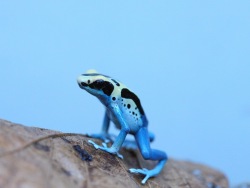Small but deadly dangerous.

Three species of dyeing dart frogs have been added to the collection of amphibians inhabiting the “Tropical Rainforest” exhibit. The species are native to South America where local tribes used their poison to coat the tips of blowgun darts. The toxin secreted through the skin of dyeing dart frogs is neuroparalytic and deadly both to animals and humans.
“The frogs don’t synthesize their poison themselves but accumulate toxins from their prey such as beetles, termites and some other insects. The poison serves as a defense against predators,” said Artem Gerasimenko, Chief Specialist of the Tropical Rainforest Department. “Our dyeing dart frogs feed on cockroaches, small fruit flies, crickets, woodlice and myriapods that are non-poisonous insects, and the frogs can get no poison from them. But, in any case, the amphibians should be handled with gloved hands.”
Dyeing dart frogs are rather small, their length doesn’t exceed 5-6 cm. They dwell in the understory layer of tropical rainforests and, unlike most of amphibians, are active during the day. There are about 30 species of dyeing dart frogs varying from each other in colour which depends mainly on their habitat.
The exhibit is home to three morphs of dyeing dart frogs - the Patricia, Alanis and Citronella morphs. The Citronella and Alanis morphs are golden yellow and black but in the Alanis morph the prevailing colour is black, and the Citronella morph has spotted legs. The Patricia morph also has black and yellow coloration but its legs are pale blue. To avoid conflicts among the frogs, specimens of each morph are kept in small groups in separate terrarium tanks. The ideal combination for their peaceful coexistence is one male and three females.
The Aquarium’s dyeing dart frogs are 6 months old, they will mature at the age of 12 to 18 months. It’s noteworthy that the main part in caring for their young is played by males, not females. After the female lays 3 to 4 eggs, a male fertilizes them. When tadpoles hatch out of the eggs, the male carry them on its back to a nearby body of water which the parent usually finds in a bromeliad axil filled with rainwater.